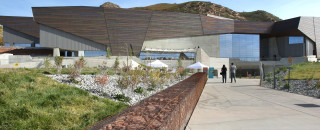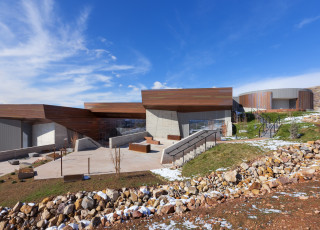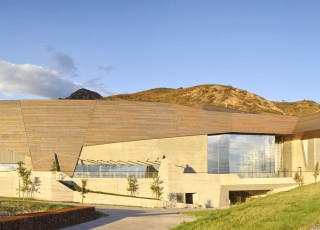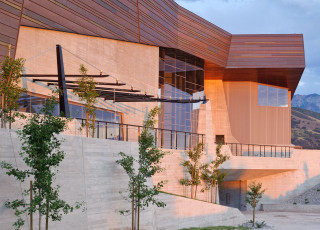Blazing Trails at the Natural History Museum of Utah
Not far from the heart of Salt Lake City, lies a gateway into the wonders of Utah’s natural spaces and places. The Natural History Museum of Utah, at the award-winning Rio Tinto Center, has laid down roots at the base of the Wasatch Mountains. Surrounded by awe-inspiring views of the valley below and the mountains behind, the Museum staff of about 200, with more than 250 volunteers is fully engaged in a mission to illuminate the natural world and the place of humans within it.
Since the 2011 move from the center of the University of Utah campus to a spot just above the Bonneville Shoreline Trail, the Museum has become a veritable beehive of activity. “We love that our new space has made it possible for us to welcome between 250,000 to 300,000 visitors per year,” says Executive Director Sarah George. “We are a primary attraction for people who want to learn more about Utah’s geology, environments, archaeological past and native peoples, and although the program isn’t new, we also provide extensive science education to schools and teachers statewide.”
Teachers interested in workshops and professional development can take advantage of Museum outreach programs, such as Taking Learning Outdoors, where teachers are taught ways to use outdoor environments to promote and enhance student learning. Other outreach programs, such as Museum on the Move, use actual Museum specimens to teach Utah 4th graders how to observe, discuss ideas and ask questions just as real scientists do. In fact, nearly 50,000 school kids visit the Museum each year, and Museum educators visit an additional 55,000 students in classrooms across the state.
Of course, with a constant stream of visitors to the Museum’s 10 permanent galleries, keeping puzzles, pumps and all interactive parts in working order is an ongoing challenge for the small exhibit staff. “Dealing with guest erosion is just part of what we do,” says Tim Lee, Exhibits Manager and Senior Designer.” We also develop, design, fabricate and install traveling and on-site exhibits, as well as manage and install at least two special exhibits each year.”
That’s a pretty strenuous pace to maintain, but everyone at the Museum seems to be riding the wave of exponential growth. Just ask Gallery Programs Coordinator, Paulmichael Maxfield, and he’ll tell you kids are especially fascinated by the many live animal opportunities offered on Saturdays at the Museum. Utah Animals, Bug Brigade and Birds in the Lab make it possible for visitors to examine and handle live bugs, lizards and frogs and to see amazing raptors and birds of prey up close. The Museum also hosts an extensive Summer Camp program that supplements learning with a healthy dose of fun.
Many Museum visitors speak highly of the quality merchandise and beautiful displays in the compact and charming Museum store. Sales in the new location have exceeded expectations, according to store manager Suzanne Ruhlman. And to top it off, the store was awarded Salt Lake Magazine’s 2012 BEST in STATE for “most unique jewelry.”
With so much to see and do, Museum-goers frequently run out of energy climbing stairs, sculpting sand and cranking rainwater into ancient Lake Bonneville. Luckily, weary explorers can ward off starvation and sit for a spell at the Museum Café, where the atmosphere is friendly and the views are breathtaking. Café manager, Paul Mulder’s simple but healthy menu focuses on fresh ingredients from local vendors, and his on-site event catering services have become wildly popular.
Groups and individuals looking to host private events are choosing the impressive architecture and unique mountain setting at the Museum as a backdrop for conferences, banquets, weddings, lectures and business meetings. Averaging three to four events a week keeps the event staff on their toes, and visitor feedback is consistently glowing. One Canadian conference-goer recently raved, “The museum is absolutely stunning.”
Even the building itself has risen to greener, more sustainable heights by earning its LEED-Gold certification, as of July 2013. In short, LEED (Leadership in Energy and Environmental Design) rating and certification systems recognize specific building strategies and practices that reduce waste, improve energy and resource efficiency and promote healthy physical environments. Although most of these sustainable features are invisible to the naked eye, visitors to the Sky Terrace often say how much they love seeing native plants and the rooftop solar array (1,378 panels) alongside panoramic views of the Salt Lake valley.
Surprisingly though, many visitors are unaware that more than half of the Museum houses a world-class research institution, with state-of-the-art laboratories and climate-controlled spaces for the more than 1.6 million artifacts and specimens. Students studying anthropology, botany, entomology, malacology, mineralogy, paleontology and zoology at the University of Utah often receive training at the Museum, as do the University’s Urban Rangers. Many graduate students are able to work alongside Museum faculty conducting research and participating in field studies throughout Utah and around the world. Then once a year, Museum visitors are invited Behind the Scenes to meet scientists, learn more about current research projects and to sneak-a-peek at Museum collections not typically available to the public.
The Natural History Museum of Utah is blazing trails with its engaging exhibits and exciting programming designed for people of all ages and interests. It’s the premiere place for locals and out-of-state visitors to discover and explore their own personal connections with Utah’s diverse natural world.
Press contacts and links
-
Press Contact
Beth Mitchell



